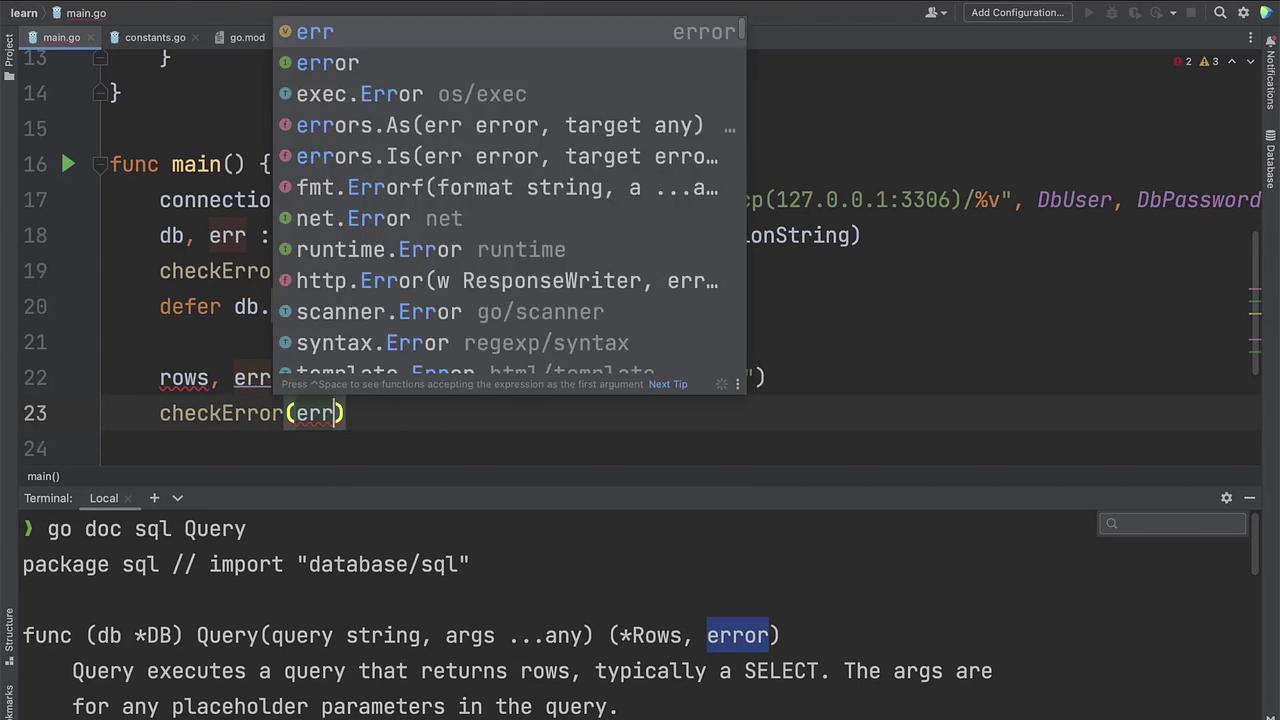Advanced Golang
API Development Project
MySQL Package
In this guide, you'll learn how to integrate a MySQL database into your Go project using the SQL package and explore useful methods for common database operations. Follow along to set up your MySQL database, create tables, and execute queries and commands using Go.
Setting Up MySQL and Creating the Database
Begin by installing MySQL on your system and logging into the MySQL console. Once logged in, create a database named "learning" with the following commands:
mysql> create database learning;
Query OK, 1 row affected (0.01 sec)
mysql> use learning;
Database changed
Next, create a simple table called data that includes two fields:
- An integer
idas the primary key. - A
namecolumn of typeVARCHAR(255)used for storing strings.
mysql> CREATE TABLE data (
-> id INT PRIMARY KEY,
-> name VARCHAR(255)
-> );
Table Structure Overview
The data table consists of an id (primary key) and a name field. This structure is suitable for basic storage, demonstration purposes, or further expansion in your applications.
Inserting and Verifying Data
Insert some sample records into the table using the following SQL commands:
mysql> insert into data values(1, "abc");
Query OK, 1 row affected (0.00 sec)
mysql> insert into data values(2, "defg");
Query OK, 1 row affected (0.00 sec)
mysql> insert into data values(3, "hij");
Query OK, 1 row affected (0.01 sec)
To confirm the inserted data, run a SELECT query:
mysql> select * from data;
+----+------+
| id | name |
+----+------+
| 1 | abc |
| 2 | defg |
| 3 | hij |
+----+------+
3 rows in set (0.00 sec)
Later in the project, you will add additional rows using the SQL package in Go.
Installing the SQL Package and Setting Up Your Project
To work with MySQL in Go, install the third-party driver package with:
go get github.com/go-sql-driver/mysql
Create a file named constants.go to store your database connection details as constants. For example, if your database is named "learning" and your username is "root", define the constants as follows (remember to properly secure sensitive information in a real project):
package main
const DBName = "learning"
const DbUser = "root"
const DbPassword = "your_password_here"
Establishing a Database Connection in Go
In your main.go file, import the MySQL driver for its side effects and open a new MySQL connection:
package main
import (
"database/sql"
"fmt"
"log"
_ "github.com/go-sql-driver/mysql"
)
func main() {
// Form the connection string using the constants defined in constants.go
connectionString := fmt.Sprintf("%v:%v@tcp(127.0.0.1:3306)/%v", DbUser, DbPassword, DBName)
// Open a database connection using the MySQL driver
db, err := sql.Open("mysql", connectionString)
checkError(err)
defer db.Close()
// Continue with further database operations...
}
The function sql.Open accepts a driver name and a corresponding data source name. For more details, refer to the Go documentation:
// go doc sql.Open
package sql // import "database/sql"
func Open(driverName, dataSourceName string) (*DB, error)
To ensure the connection is established correctly, use this helper function to check for errors:
package main
import "log"
func checkError(e error) {
if e != nil {
log.Fatal(e)
}
}
Querying the Database
Selecting Data
To retrieve rows from the data table, use the Query method as shown below:
rows, err := db.Query("SELECT * FROM data")
checkError(err)
For more details on the Query method, see the Go documentation:
// go doc sql.Query
package sql // import "database/sql"
func (db *DB) Query(query string, args ...any) (*Rows, error)
Define a struct to hold the query results:
type Data struct {
id int
name string
}
Loop through the result set using the Next and Scan methods to print each row:
for rows.Next() {
var data Data
err := rows.Scan(&data.id, &data.name)
checkError(err)
fmt.Println(data)
}
The Next method prepares the next row for reading, while Scan copies the column values into the provided variables. Their official documentation includes:
// go doc
func (rs *Rows) Next() bool
// and
func (rs *Rows) Scan(dest ...any) error
Inserting Data via Go
After validating your SELECT query, insert a new row into the table using the Exec method:
result, err := db.Exec("INSERT INTO data VALUES(4, 'xyz')")
checkError(err)
Retrieve details about the execution, such as the last inserted ID and the number of rows affected:
// LastInsertId returns the integer generated by the database in response to an INSERT command.
lastInsertedId, err := result.LastInsertId()
checkError(err)
fmt.Println("lastInsertedId:", lastInsertedId)
// RowsAffected returns the number of rows affected by an update, insert, or delete.
rowsAffected, err := result.RowsAffected()
checkError(err)
fmt.Println("rowsAffected:", rowsAffected)
Verify the insertion by running another SELECT query and printing the results:
rows, err = db.Query("SELECT * FROM data")
checkError(err)
for rows.Next() {
var data Data
err := rows.Scan(&data.id, &data.name)
checkError(err)
fmt.Println(data)
}
When you run the program, the expected output should be similar to:
lastInsertedId: 0
rowsAffected: 1
{1 abc}
{2 defg}
{3 hij}
{4 xyz}
You can also confirm the new row in the MySQL console:
mysql> select * from data;
+----+------+
| id | name |
+----+------+
| 1 | abc |
| 2 | defg |
| 3 | hij |
| 4 | xyz |
+----+------+
4 rows in set (0.00 sec)
Conclusion
With these instructions, you now have a solid understanding of how to integrate MySQL with Go using the SQL package. You have learned to create a database and table, insert data, and perform both SELECT and INSERT operations programmatically. Use these techniques to build robust database operations in your Go projects.

Security Reminder
Always ensure that your database credentials are stored securely and consider using environment variables or secret management tools for production applications.
Watch Video
Watch video content